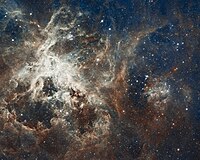Black spot on Jupiter is impact site, says NASA
Tuesday, July 21, 2009

Image: NASA/JPL/Infrared Telescope Facility.
A black spot about the size of the Earth that appeared on the upper cloud surface of the planet Jupiter on July 19 has been confirmed to be the result of a massive object, probably a comet or asteroid, crashing into the planet, according to the results of infrared observations of the planet taken at NASA's Mauna Kea Observatory.
The spot, located near Jupiter's south pole, was first reported by Anthony Wesley, an amateur astronomer from Murrumbateman, New South Wales, Australia who was observing the planet late on the 19th Australia time, around 1330 on July 20 GMT. Wesley called in a tip to NASA, whose Jet Propulsion Laboratory (JPL) began their own observations at the Infrared Telescope Facility. A team under Glenn Orton then confirmed Wesley's original theory, citing similarities between the black, hot region in the atmosphere and the aftermath of the impact of Comet Shoemaker-Levy 9, which broke into pieces and impacted Jupiter exactly 15 years previously — July 16 to July 22, 1994.
Wesley's tip was instrumental in securing the best possible observations. "We were extremely lucky to be seeing Jupiter at exactly the right time, the right hour, the right side of Jupiter to witness the event. We couldn't have planned it better", said Orton in a NASA press release. Leigh Flecther, a postdoctoral fellow at JPL, called the observations "the most exciting observations I've seen in my five years of observing the outer planets!"
Wesley almost missed observing the spot. He told the Guardian, "I was imaging Jupiter until about midnight and seriously thought about packing up and going back to the house to watch the golf and the cricket. In the end I decided to just take a break and I went back to the house to watch Tom Watson almost make history. I came back down half an hour later and I could see this black mark had turned into view."
Unlike Comet Shoemaker-Levy 9, the object responsible for Jupiter's new black spot was not detected prior to its impact.
Sources
- Toni O'Loughlin. "Amateur astronomer spots Earth-size scar on Jupiter" — The Guardian, July 21, 2009
- "Mystery impact leaves Earth-size mark on Jupiter" — CNN, July 21, 2009
- Carolina Martinez. "New NASA Images Indicate Object Hits Jupiter" — Jet Propulsion Laboratory, July 20, 2009
- Anthony Wesley. "Impact mark on Jupiter, 19th July 2009" — jupiter.samba.org, July 19, 2009
